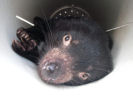Mystery of Tasmanian devil tumour deepens
 Here is a short report from University of Sydney about recent research which threw into doubt the role of genetic inbreeding as a factor in lack of immune defense against the killer tumours in devils.
Here is a short report from University of Sydney about recent research which threw into doubt the role of genetic inbreeding as a factor in lack of immune defense against the killer tumours in devils.
Picture: "Tasmanian Devil." Photo by Rodrigo Hamede, University of Tasmania.
Mystery of Tasmanian devil tumour deepens – for now
The degree of genetic difference to a tumour rapidly decimating the ranks of Tasmanian devils (Sarcophilus harrisii) is not a factor in their likelihood of contracting the disease, according to research led by the University of Sydney.
The finding, published today in PLoS, the Public Library of Science journal, surprised researchers and means they will take a different approach in the race to better understand the Devil Facial Tumour Disease (DFTD), a contagious cancer which has already wiped out 85 percent of all Tasmanian devils.
“We looked at the West Pencil Pine population, in north-western Tasmania because they are the first population to be less severely affected by DFTD than other populations,” said Professor Kathy Belov, the senior author of the study from the University’s Faculty of Veterinary Science.
In West Pencil Pine there is lower prevalence of the disease, increased survival time of infected individuals and little indication of changes in population size or population growth rate, four years after the disease was first detected.
“We thought that differences in certain key immune genes might explain the different susceptibility patterns between devils in West Pencil Pine and other devils,” Professor Belov said.
Due to devil populations having low genetic diversity most Tasmanian devils share the same Major Histocompatibility Complex (MHC) genes as tumours. The researchers believed that since the tumours were genetically similar to individual devil’s own cells their immune system wouldn’t recognise that the cancer cells were foreign and wouldn’t attack them.
“Many of the devils at West Pencil Pine are genetically different to the animals in the east of the state. We thought these genetically different animals might be able to mount an immune response against the tumours,” Professor Belov said.
“We thought devils that were most genetically different to the tumours would be less likely to catch DFTD. This isn’t the case.”
The researchers will have to go back to the drawing board to try to work out why DFTD is affecting genetically different devils.
“It is possible the tumour itself is suppressing the immune response in some way. We also know that DFTD is evolving and changing over time. Perhaps the strain of DFTD in West Pencil Pine is different and that is why fewer animals are getting sick in that region,” Professor Belov said.
The next step will be to look more closely at the tumours in West Pencil Pine and at genetic difference across the entire devil genome, rather than simply focusing on the MHC genes. West Pencil Pine may still hold the key to why some devils catch DFTD and others do not.
The other contributing authors to the PLoS paper include Dr Amanda Lane, Yuanyuan Cheng, Belinda Wright, Dr Laura LeVan an and Dr Beata Ujvari from the University of Sydney and Dr Menna Jones and Dr Rodrigo Hamede from the University of Tasmania.
Media contact:
Verity Leatherdale: (02) 9351 4312, 0403 067 342 or verity.leatherdale[AT]sydney.edu.au

Recent comments